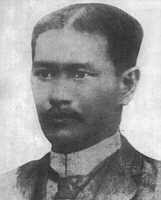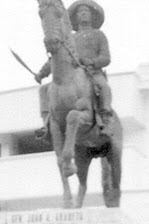(By: Dr.Jose Palu-ay Dacudao-INM: Butuan City, Philippines)
“Ice had formed ahead of them, and it reached all the way to the sky. The people could not cross it… A Raven flew up and struck the ice and cracked it. Coyote said, “These small people can’t get across the ice.” Another Raven flew up again and cracked the ice again. Coyote said, “Try again.” Raven flew up again and broke the ice. The people ran across.”
(A Legend of the Paiute ethnic people, describing a time more than 10,000 years ago when their ancestors braved the glaciers of the ice age as they traveled from Asia to America.)
I was just reading an article on Russian History. The Russians start their story at their roots as a Slavic ethnic people during pre- Christian times, inhabiting Eastern Europe . The eastern Slavic tribes were eventually organized by Scandinavian traders called Varangians or Rus (from where Russians took their ethnic name) into a single state in the 800s. These Rus established the ruling House of Ryurik around that time. In 882 AD, Kiev and Novgorod (the two main Eastern Slavic principalities) were united as the state of Kievan Rus under a single ruler from the house of Ryurik. In 980 Vladimir I (son of Svyatoslav, a warrior king who spent his entire life conquering and expanding Kievan Rus) became ruler. Eight years later he converted to Orthodox Christianity and made Orthodoxy the official religion of Kievan Rus. The Church of the Rus used Slavonic (the language of the Slavs as it was known then) in its liturgy. The present-day Russian, Ukrainian, and Belorussian nations trace their ethnic and political lineage to the Kievan Rus.
Notice that the Russians always start at their origins as an ethnic people, speaking a distinct language. So do practically all nations and nationalities today. If so, there is something grossly askew with the way history is being taught in Philippine schools..
As told in all Philippine schools by the Manila-based Educational curriculum:
NOTHING whatever is mentioned of the origins of the ethnic peoples of the Philippines .
The Russians clearly know that they are a Slavic people, defined by a Slavic language, and a distinct history.. What do we Visayans know of our ethnic origins? Mostly NOTHING, but it’s not our fault because our Educational system is controlled by Tagalista Institutions and individuals who mostly tell THEIR story, which naturally tends to be a Tagalog story, with Tagalog heroes and movements. OUR fault is that we take this propaganda standing down, when we should be telling the story of our people to our children from OUR point of view.
The usual tale (as told by Manila-based institutions) of the Philippines starts when the Portugese explorer Ferdinand Magellan, under the auspices of the Spanish Government, ‘discovered’ the Philippines in 1521. The Tagalogs then were simply ‘taga-ilog’ or literally ‘people living by the river’.
This is not so with the Visayans.
In disinterested sources, the first polity that is always mentioned as having influence in what today is called the Philippines is always the SRI VISAYA Empire. For instance, regarding the only major polity that affected pre-Spanish Philippines , the Encyclopedia Encarta, says:
“By the 12th century ad the powerful Sumatra-based Malay kingdom of Sri Vijaya had extended its considerable influence to the Philippines .”
Present day Visayan languages have practically dropped the phonemes ‘v’ and ‘j’ and so we would pronounce ‘Sri-Vijaya or ‘Shri-Vishaya’ (as written in literature) as ‘siri-bisaya’.
From the Cappeller Sanskrit English Dictionary [
Entry viSaya
Meaning m. reach, sphere, domain, province, country; the right place for (gen.);
‘Sri’ or ‘Shri’ is a Hindu-Budhist Indian honorific. Kabisayaan then literally means ‘Our Country’. To speak ‘Binisaya’ means speaking our own language. ‘Bisaya nga manok’ means native chicken.
What was the Sri Visayan Empire? If one were to surf the internet, one would quickly discover that the Sri Visaya was the longest living Empire in history, outlasting even the Roman Empire in its longevity. It had its origins in the 400s (possibly even as early as 200 AD) and died out in the 1300s. Our neighbors in Indonesia , Malaysia , and Brunei seem to be making capital out of this fact, and seem to be presenting themselves to the world community as the direct political and cultural descendants of longest Empire the world has ever known.
The Sri Visayan rulers were converted to Buddhism early in their history. (There are indications that Buddhism mostly stayed as a court religion, with most ordinary citizens remaining animists, and even much of the nobility seemed to have been interested in Buddhism more for its magical aspects rather then its theological message.) Practically all culturally advanced artifacts dug up in Archipelagic Asia more than a thousand years ago have something to do with the Sri Visaya. Its culture included impressive iron, glass, and dyed fabric technology. A culture that could produce iron implements is definitely not a pushover. The lifeblood of this Empire was the sea-based Persian trade route (the alternative trade route to the land-based Silk Route used by the famous explorer Marc Polo) between Europe and China , and its boat-making technology, which was a necessity in this trade, allowed it to span across the islands of Archipelagic Asia. At its peak, Sri Visaya had an army of 20,000, which could be regarded as small for its status, but then again Sri Visaya was fundamentally a tolerant economic Empire. It was multilingual, and allowed much autonomy for its component principalities, which might be one of the reasons why it lasted so long. (Pro-Federal readers who always argue for autonomy for the LGU’s should take heart in this.)
The Panay Atis may actually have a cultural memory of the Visayans’ arrival. One of the Ati sayings, describing a time when the Visayans still had not arrived in the Philipipines, goes as follows:
“Gurang tamon sa Bisaya,
Labi pa sa Katsila.”
As a matter of fact, we Ilonggo Visayans ourselves have a cultural memory of our ethnic ancestors’ arrival in the Visayas, in the often told tale of the 10 datus. As in all legends, this is just a legend and most disinterested archaeologists would concur that one should not take it too literally. However as with many legends, it is based on fact. Chinese Ming dynasty records (the Chinese were naturally friendly with the Sri Visayans who were their business partners) tell of mass migrations by Sri-Visayan datus fleeing from war-torn Sri-Visaya at its end in the 1300s, coinciding with the timeline of the legend of the 10 datus.
One of the versions of the legend of the 10 datus starts with civil strife in the troubled Sri-Visayan principality of Brunei Borneo just after the fall of the Empire in the 1300s. Sultan Makatunaw of Borneo proved to be such a tyrant that 10 of the nobility fled Borneo together with their clans in the giant outrigger boats typical of the seafaring Sri-Visayan culture, boats known to us as Balanghais, or Baranggays, or Biniray. (The mostly land-bound Chinese apparently had some respect for these boats, as they mention them in their records, as the boats of their Sri-Visayan business partners in the Persian trade.)
The 10 Bornean datus (among them Puti, Sumakwel, Dumangsil, Lubay, Balakasusa, Bangkaya, Paiburong, Dumalogdog), along with other personalities, to make the long legend short, arrived in Panay island, and then bought the whole island from the Ati Chief Marikudo with a golden necklace (upon the insistence of Marikudo’s wife Maniwantiwan) .
Perhaps every normal Ilonggo child grows up knowing that the Atis sold Panay to the Bisaya for a golden necklace. It is a living legend, one that is taught in homes and not in schools.
In actuality, Balanghais and other Sri-Visayan artifacts such as the golden tiara (not a golden salakot) have been dug up in Butuan, that indicate that Sri-Visaya had a presence in what today is the Philippines as far back as the 900s. Since the Philippines was directly in the trade route between the Sri Visayan capital of Palembang Sumatra and China , the Sri Visayans had to establish some kind of presence here, as indicated by such artifacts. Near the end of the Empire, the waves of Visayan migrations are remembered in our culture with legends such as the 10 datus (and officially in Ming Dynasty records).
While not literally accurate, and while these early Visayan migrants must have intermarried with other peoples, the legend carries a kernel of truth that we Visayans should be aware of:
That our ethnic identity is directly derived from the peoples of the great Sri-Visayan Empire, the longest lasting Empire in the world. We actually carry its name, passed on to us present-day Visayans for generations spanning more than a thousand years! Few ethnic peoples could boast of such a claim.
Let us do our ethnic ancestors proud!
After all these years we Visayans still carry the ethnic identity of this Empire. We are not told of this in our schools, controlled by Manila-based institutions, yet every child growing up in the Visayas and most parts of Mindanao is still imbibed with the ethnic identity of being ‘Bisaya’ for as long as he or she speaks one of the Visayan languages.
Next time someone from Manila or a Tagalista or plain ‘Taga-Ilog’ degrades our languages, culture, and identity, or insists on us speaking their language as it is in their opinion the ‘national language’, remember that. We Visayans had a long and glorious history beginning more than a thousand years before Magellan ever set foot here.
Mga Kasimanwa, do teach our Visayan languages to our children at home so that they will grow up as Visayans, and let us always lobby for the formal teaching of our languages in our schools!


















3 comments:
really like this and improud to be an ilonggo which my roots is from guimbal...hope that this will reach to our officials that represent ilonggo nation. to include this in the books text
Born and raised in Manila by an Aklanon father and Ilonggo mother, I thought of what was happening in the other parts of the 'Philippines' if everything in our school textbooks are all about Manila and Katagalugan? I always questioned why we Visayans collectively called ourselves Visayan. For no other reason than to do so? For Spanish convenience (I could still remember and laugh at how we were convinced that 'Visayas' as a name was a corruption of the Spanish 'vice' as in, quoted from my teachers, "like Vice President meaning SECOND"? Then why didn't they just continue to use our islands' different names?
I believe the successive historical experiences we have had as people is the reason why we are oblivious of our glorious past. The Spanish was to blame for purging or indigenous Hindu-Buddhist-Animist traditions and history, and the Americans for tolerating Tagalog ambitions to expand legal control over the Spanish East Indies claiming we were meant to be one state out of petty fabricated legends such as the "Maharlika" which never existed anyway.
This is just very informative, and thanks for posting it. People tend to just focus to Spanish colonial, they forgot that there's something still beneath it. Thanks again, you're the hero.
Post a Comment